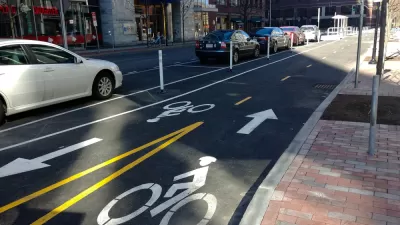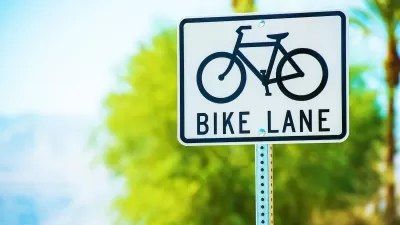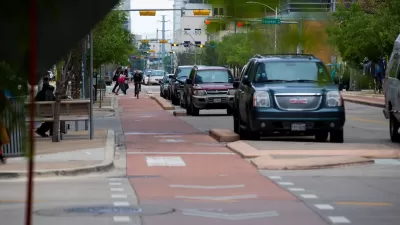New research from the University of Colorado Denver and the University of New Mexico sheds light on how to make cities safer for cyclists and other road users and refutes some assumptions about bike safety, such as "safety-in-numbers."

"In the most comprehensive look at bicycle and road safety to date, researchers at the University of Colorado Denver and the University of New Mexico discovered that it’s not the cyclists, but the infrastructure built for them, that is making roads safer for everyone," writes Rachel Sturtz, research specialist for the University of Colorado Denver.
The 13-year study of 12 cities was published in the Journal of Transport & Health on May 29. Sturtz's article was also published in Science Daily and Science Magazine. It is the second study in as many months to make the case for protected bike lanes over conventional bike lanes.
Originally, researchers believed that more bike lanes and the increase in cyclists would lead to a “safety-in-numbers” effect: the more cyclists on the road, the more likely drivers would slow down and be aware of their surroundings. Instead, they found that safer cities aren’t due to the increase in cyclists, but the infrastructure built for them – specifically, separated and protected bike lanes. They found that bicycling infrastructure is significantly associated with fewer fatalities and better road-safety outcomes.
"Building safe facilities for cyclists turned out to be one of the biggest factors in road safety for everyone,” said study co-author Wesley Marshall, PhD, PE, assistant professor in the College of Engineering, Design and Computing [and affiliate professor in Urban and Regional Planning at the University of Colorado Denver].
"When we believed it was the old safety-in-numbers concept, that meant we had to figure out how to get more people on bicycles to make a city safer,” said co-author Nicholas Ferenchak, PhD, assistant professor in the department of Civil, Construction and Environmental Engineering at the University of New Mexico. “That’s not easy. But this research has boiled it down for city planners: create cycling facilities, and you’ll see the impact.”
More cycling means more crashes, but not all crashes are major.
"To reduce deaths, cities need more evidence-based research to help them make better policy decisions," adds Sturtz. "Focusing on fatalities – not crashes – is important."
“Over the years, my research has found that safer cities have fewer fatalities but more fender benders,” Marshall said.
Streetsblog and The Independent report on the landmark study
Aaron Short, writing for Streetsblog USA, and Tom Batchelor, at London-based The Independent, point to the findings as they relate to sharrows and conventional bike lanes, those separated from the traffic lanes by a narrow white line, with the asphalt sometimes painted green.
"Researchers assumed that having more cyclists on the street was spurring drivers to slow down — a relic of a 2017 study [also co-authored by Marshall] that found that cities with high cycling rates had fewer traffic crashes," writes Short. "But it turned out that wasn’t the case."
Perhaps even more important: Researchers found that painted bike lanes provided no improvement on road safety. And their review of shared roadways — where bike symbols [known as sharrows] are painted in the middle of a lane — revealed that it was actually safer to have no bike markings at all. [The sharrows research, based on "dooring crashes" in Chicago, was released this month by Marshall and Ferenchak.
Furthermore, Short distinguishes between types of protected bike lanes.
Not all protected bike lanes provide the same level of security for cyclists and drivers. In Denver, for instance, some protected lanes have plastic bollards that are interspersed along the roadway, allowing cars and trucks to park in the bike path and forcing cyclists to swerve into the street.
“When you have them designed like that, even if it’s a protected lane, that might create a more dangerous situation because cyclists are merging in and out of the road versus places with foot-wide concrete planters,” Marshall added.
London takes notice
“Regular, painted bike lanes turned out to be insignificant,” study co-author Wesley Marshall told The Independent. ”They may help in terms of bicyclist safety but weren’t a factor when we focused on all road users.”
Simon Munk, infrastructure lead at the London Cycling Campaign, told The Independent the latest research showed it was “imperative for the [London] mayor to crack on and deliver his pledge to triple the amount of segregated cycle lanes on main roads.
He added: “Sadiq Khan is on track to do that but it is important that the next mayor continues to accelerate the pace of change.
Cities studied
The Science Daily summary notes the 12 cities included in this research: Oklahoma City, Memphis, Kansas City, Mo., Dallas, Houston, Austin, Chicago, Denver, Seattle, San Francisco, Minneapolis and Portland [Ore.]. "As this study focuses on larger cities, the results are not generalizable to smaller cities."
Short adds for Streetsblog that "New York was not included in this longitudinal study because the high number of cyclists and lanes would have overwhelmed their models, but will be a focus of a future study, Marshall said."
To access the report, it appears that one may need an account with Science Direct. An earlier version of the 162-page study [pdf] was released in December 2018 by the Mountain-Plains Consortium, a University Transportation Center sponsored by the U.S. Department of Transportation through its Research and Innovative Technology Administration.
Related in Planetizen:
-
Study: Cars Give Bike Lanes Less Space, April 16, 2019A new study provides more evidence that people on bikes need more of a buffer from drivers in cars than a mere strip of paint can offer.
-
London Has a Plan to Become the Best Big City for Cycling, December 19, 2018
-
Cycling Infrastructure Gets a Boost in London, December 10, 2016
Hat tip: Streetsblog Calif.
FULL STORY: Cycling lanes, not cyclists, lower road fatalities

Study: Maui’s Plan to Convert Vacation Rentals to Long-Term Housing Could Cause Nearly $1 Billion Economic Loss
The plan would reduce visitor accommodation by 25,% resulting in 1,900 jobs lost.

North Texas Transit Leaders Tout Benefits of TOD for Growing Region
At a summit focused on transit-oriented development, policymakers discussed how North Texas’ expanded light rail system can serve as a tool for economic growth.

Using Old Oil and Gas Wells for Green Energy Storage
Penn State researchers have found that repurposing abandoned oil and gas wells for geothermal-assisted compressed-air energy storage can boost efficiency, reduce environmental risks, and support clean energy and job transitions.

Santa Barbara Could Build Housing on County Land
County supervisors moved forward a proposal to build workforce housing on two county-owned parcels.

San Mateo Formally Opposes Freeway Project
The city council will send a letter to Caltrans urging the agency to reconsider a plan to expand the 101 through the city of San Mateo.

A Bronx Community Fights to Have its Voice Heard
After organizing and giving input for decades, the community around the Kingsbridge Armory might actually see it redeveloped — and they want to continue to have a say in how it goes.
Urban Design for Planners 1: Software Tools
This six-course series explores essential urban design concepts using open source software and equips planners with the tools they need to participate fully in the urban design process.
Planning for Universal Design
Learn the tools for implementing Universal Design in planning regulations.
Ascent Environmental
Borough of Carlisle
Institute for Housing and Urban Development Studies (IHS)
City of Grandview
Harvard GSD Executive Education
Toledo-Lucas County Plan Commissions
Salt Lake City
NYU Wagner Graduate School of Public Service





























